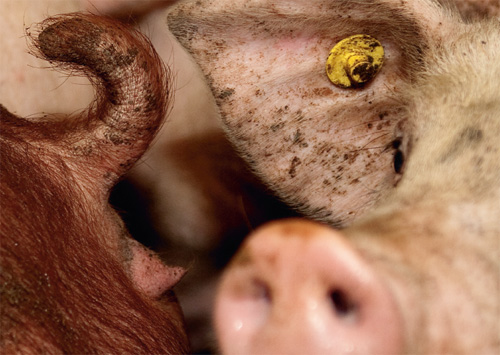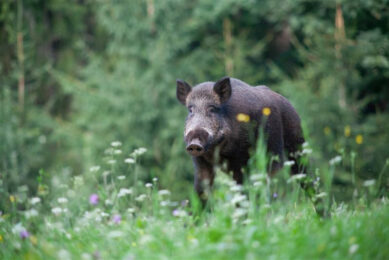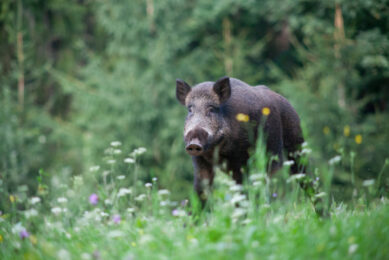How to avoid tail biting and other vices?

Tail biting is a nagging habit of some pigs which, if unchecked, can lead to severe erosion of the whole tail, as well as sepsis, stress and even death. Occurrence happens mainly when pigs are bored – they ought to rest for most of the day. Get rid of restlessness, and beat tail biting.
It has been suggested that 14% of all condemnations in Europe are due to tail biting, so the problem is a major one. Evidence of tail biting (past or present) can be seen on one in eight of the farms, even today. Table 1 gives an indication of what the most common causes are. Over 45 years a trend can be seen away from nutritional causes to those of environmental and possibly that of genetics. Producers are feeding pigs better now, but may be overcrowding them too much. Our pigs are growing very fast and could be less docile than they were decades ago.
Primary causes – something to do
Pigs have a natural rooting instinct. They are inquisitive, curious, aware animals, and when not eating, drinking and sleeping, are looking for ‘something to do’.
Yet we keep them in ‘overcrowded’ and ‘unnatural’ conditions. The dictates of modern production practices means we have to do this – compared to the wild anyway. We have to ensure we do not overstep the overcrowding and unnaturalness boundaries. Both cause restlessness or low-level anxiety-stress (NES, Neuro-Endocrine System). Happy pigs rest for up to 82% of their time, dozing away the hours, so 18% of their time is spent up-and-about looking for something to do. And if they can’t find something to do, then they will look for trouble.
So we must give the confined grower something to do – and if rooting comes naturally, something to root – a large ball, old 15 cm ball-cocks from lavatory cisterns, a heavy log, even a sod of earth (very short-lived). Not chains, these swing about, slap other pigs in the face and tend to raise the restlessness level.
In the wild, pigs do not graze branches like cattle – they root. So give them ‘rootability’. A very good diversion is a 2 m long piece of toughened alkathene tubing, as pigs like to chew across an object as well as pushing it. Next, keep the pigs resting – comfort and a feeling of well-being helps enormously. Contented pigs do not tail bite. If the pigs aren’t dozing away 20 hours out of the 24, a restlessness audit should be held. And any producer could ask himself what he or she is doing by mistake to raise the restlessness level.
How to approach tail biting?
While the effect of tail biting is restlessness and stress, the causes are many and interrelated. Because of this combination of causative factors it is difficult for the stockperson to pinpoint the one reason which has pushed the pigs over the brink. Most producers are haphazard in their approach.
The problem is all too visible and needs urgent attention, so a wide variety of remedies are applied at once. On the short term, these are:
• Remove all bitten pigs immediately and send these pigs to a convalescent pen.
• Spray-mark all suspected biters so as to help identify the culprits.
• Do not delay – act at once or it will get worse.
• Add chewable objects. Pigs like to ‘nose’ and they like to demolish such items (‘something to do’), e.g. paper feed bags, really thick rope, a length of plastic piping, etc.
• Check stocking density and feeder space.On the longer term, one could think of:
• Try to prioritise the most likely causes and attend to them first (more on this in the book, see box).
• Only try one or two of the most likely solutions at a time, and allow enough time – about two days – for any effects to show.
• Record dates, pen numbers, weather changes, numbers of pigs affected and any noticeable changes in behaviour.
The purpose of this planned approach is to locate the cause and solve the problem permanently. It works.
One way of dealing with the problem of tail biting is to provide environmental enrichment to the pigs, which allows them to root, investigate, chew and play. Various options can be considered, of which the bedding provides an interesting range of options.
There is no doubt that pigs on straw are far less likely to tail bite. Unfortunately straw is not always available and even if it is, after a difficult harvest it can be expensive. In such cases, producers must redouble their efforts to seek other palliatives, temporary if necessary like discarded paper bags, some alternatives are discussed in Table 2.
Sand tends to wreck food conversion. Tree bark from a tree surgeon is good but avoid any inclusion of conifer, laurel and cupressus. Forest bark is widely used by the garden centres and so the price is now prohibitive.
While peat on offer is an excellent deterrent, environmental constraints preclude its use. Spent mushroom compost is equally good and is a by-product needing disposal anyway, so a word on this material for anyone near to a mushroom farm.Pioneer work in Northern Ireland, where initially shallow trays of peat or mushroom compost were placed in pens where tail biting was a problem, proved effective. However, this tended to take up a lot of pen space even though the results were good in relation to other ‘rootable’ materials.











